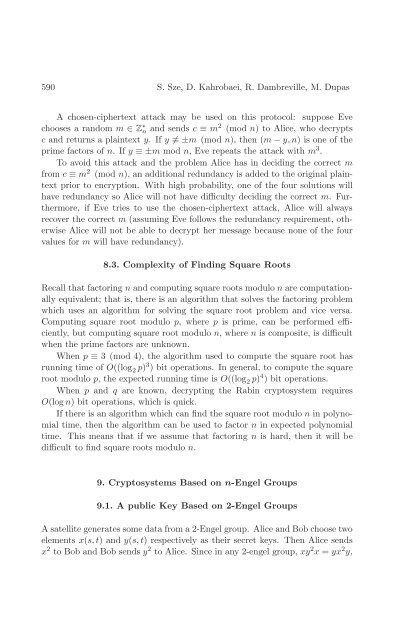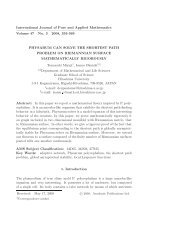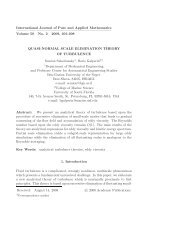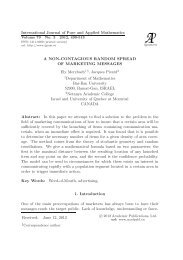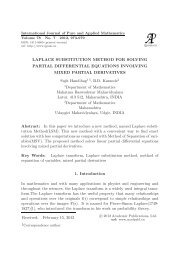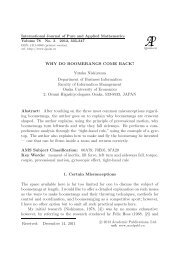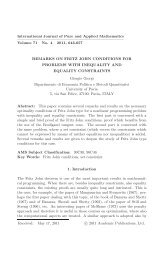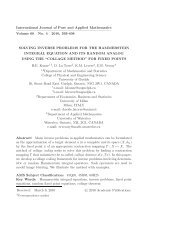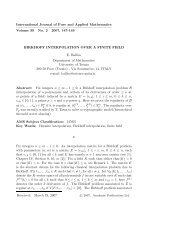FINDING N-TH ROOTS IN NILPOTENT GROUPS AND ...
FINDING N-TH ROOTS IN NILPOTENT GROUPS AND ...
FINDING N-TH ROOTS IN NILPOTENT GROUPS AND ...
You also want an ePaper? Increase the reach of your titles
YUMPU automatically turns print PDFs into web optimized ePapers that Google loves.
590 S. Sze, D. Kahrobaei, R. Dambreville, M. Dupas<br />
A chosen-ciphertext attack may be used on this protocol: suppose Eve<br />
chooses a random m ∈ Z ∗ n and sends c ≡ m 2 (mod n) to Alice, who decrypts<br />
c and returns a plaintext y. If y ≡ ±m (mod n), then (m − y,n) is one of the<br />
prime factors of n. If y ≡ ±m mod n, Eve repeats the attack with m 3 .<br />
To avoid this attack and the problem Alice has in deciding the correct m<br />
from c ≡ m 2 (mod n), an additional redundancy is added to the original plaintext<br />
prior to encryption. With high probability, one of the four solutions will<br />
have redundancy so Alice will not have difficulty deciding the correct m. Furthermore,<br />
if Eve tries to use the chosen-ciphertext attack, Alice will always<br />
recover the correct m (assuming Eve follows the redundancy requirement, otherwise<br />
Alice will not be able to decrypt her message because none of the four<br />
values for m will have redundancy).<br />
8.3. Complexity of Finding Square Roots<br />
Recall that factoring n and computing square roots modulo n are computationally<br />
equivalent; that is, there is an algorithm that solves the factoring problem<br />
which uses an algorithm for solving the square root problem and vice versa.<br />
Computing square root modulo p, where p is prime, can be performed efficiently,<br />
but computing square root modulo n, where n is composite, is difficult<br />
when the prime factors are unknown.<br />
When p ≡ 3 (mod 4), the algorithm used to compute the square root has<br />
running time of O((log 2 p) 3 ) bit operations. In general, to compute the square<br />
root modulo p, the expected running time is O((log 2 p) 4 ) bit operations.<br />
When p and q are known, decrypting the Rabin cryptosystem requires<br />
O(log n) bit operations, which is quick.<br />
If there is an algorithm which can find the square root modulo n in polynomial<br />
time, then the algorithm can be used to factor n in expected polynomial<br />
time. This means that if we assume that factoring n is hard, then it will be<br />
difficult to find square roots modulo n.<br />
9. Cryptosystems Based on n-Engel Groups<br />
9.1. A public Key Based on 2-Engel Groups<br />
A satellite generates some data from a 2-Engel group. Alice and Bob choose two<br />
elements x(s,t) and y(s,t) respectively as their secret keys. Then Alice sends<br />
x 2 to Bob and Bob sends y 2 to Alice. Since in any 2-engel group, xy 2 x = yx 2 y,


